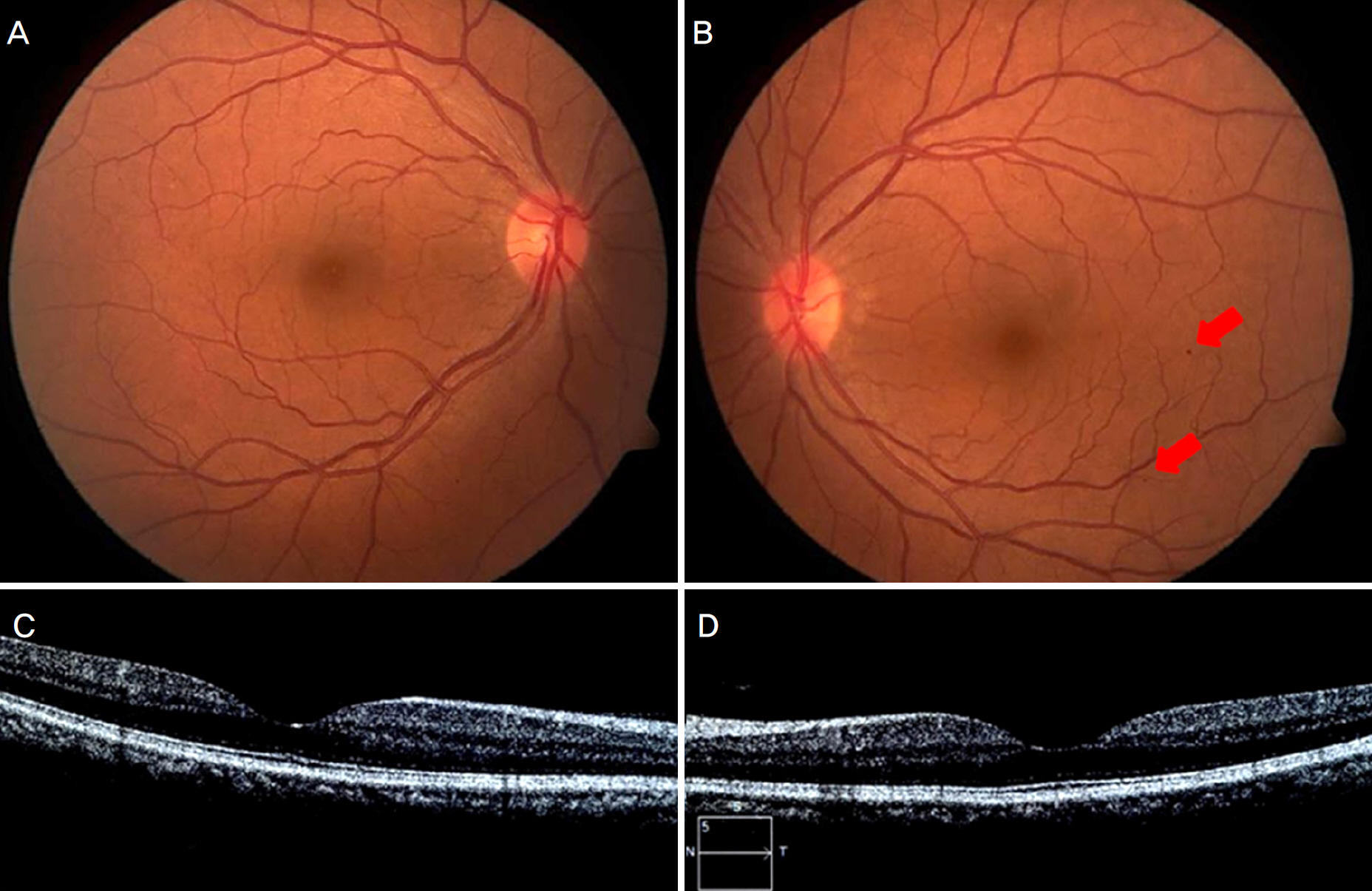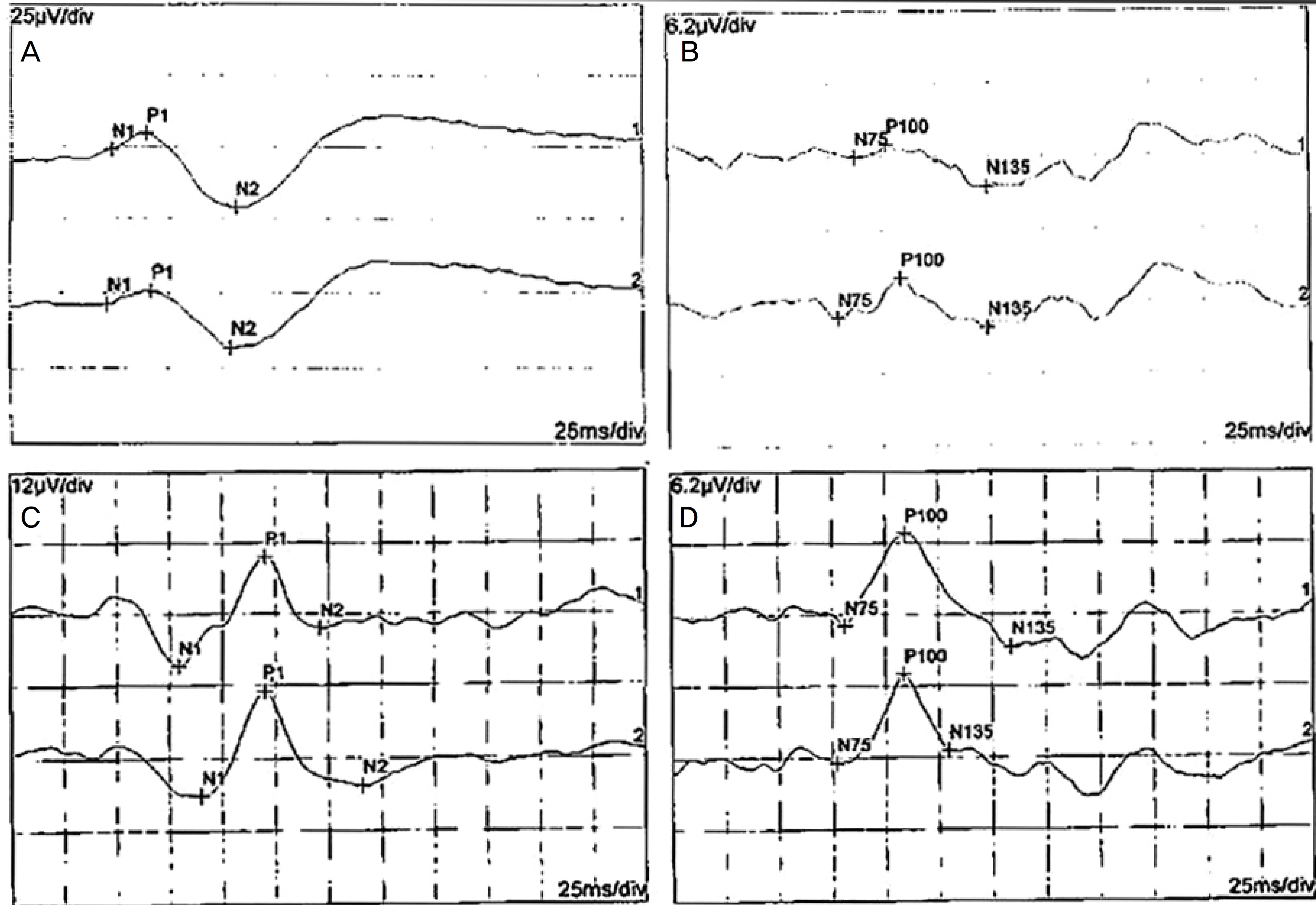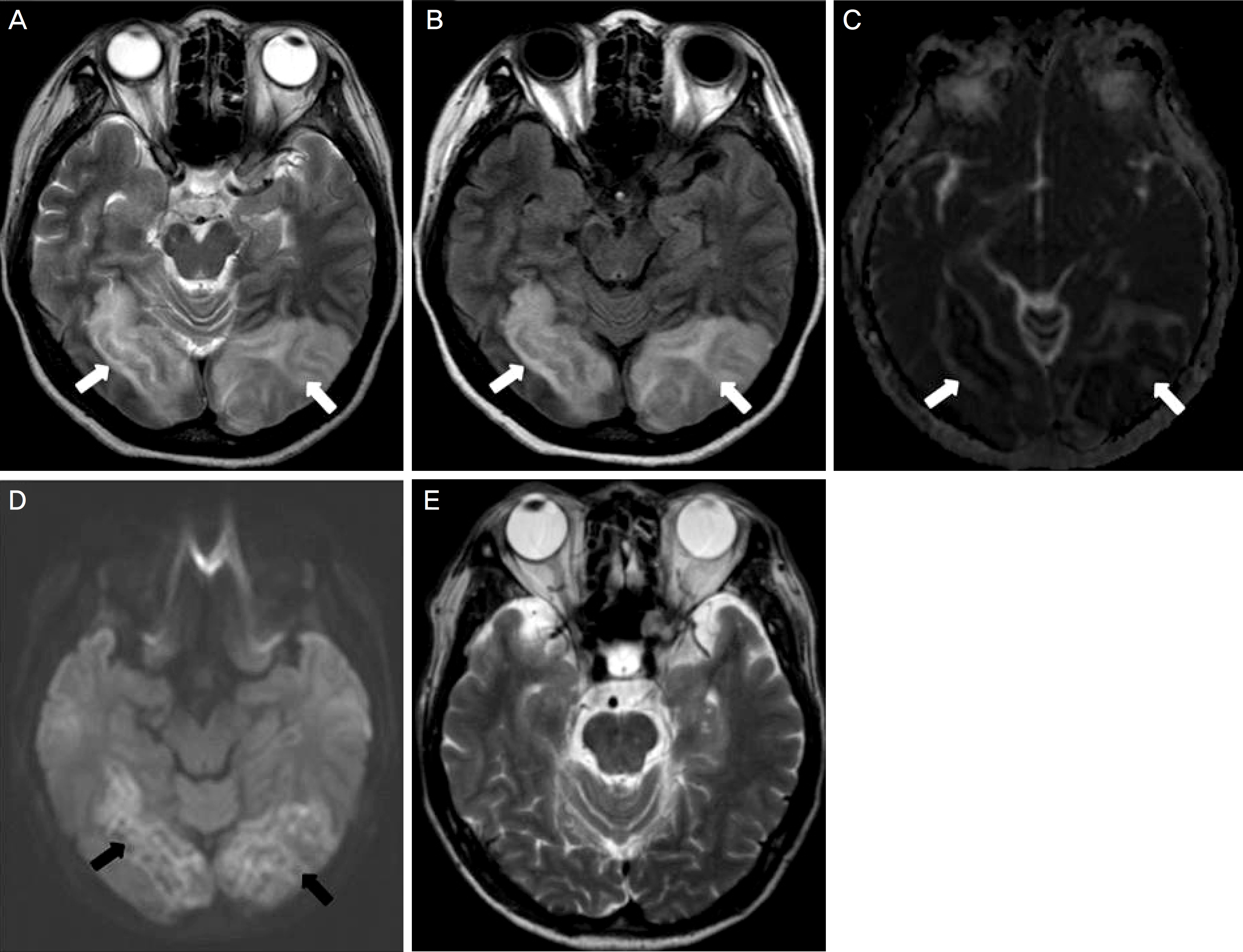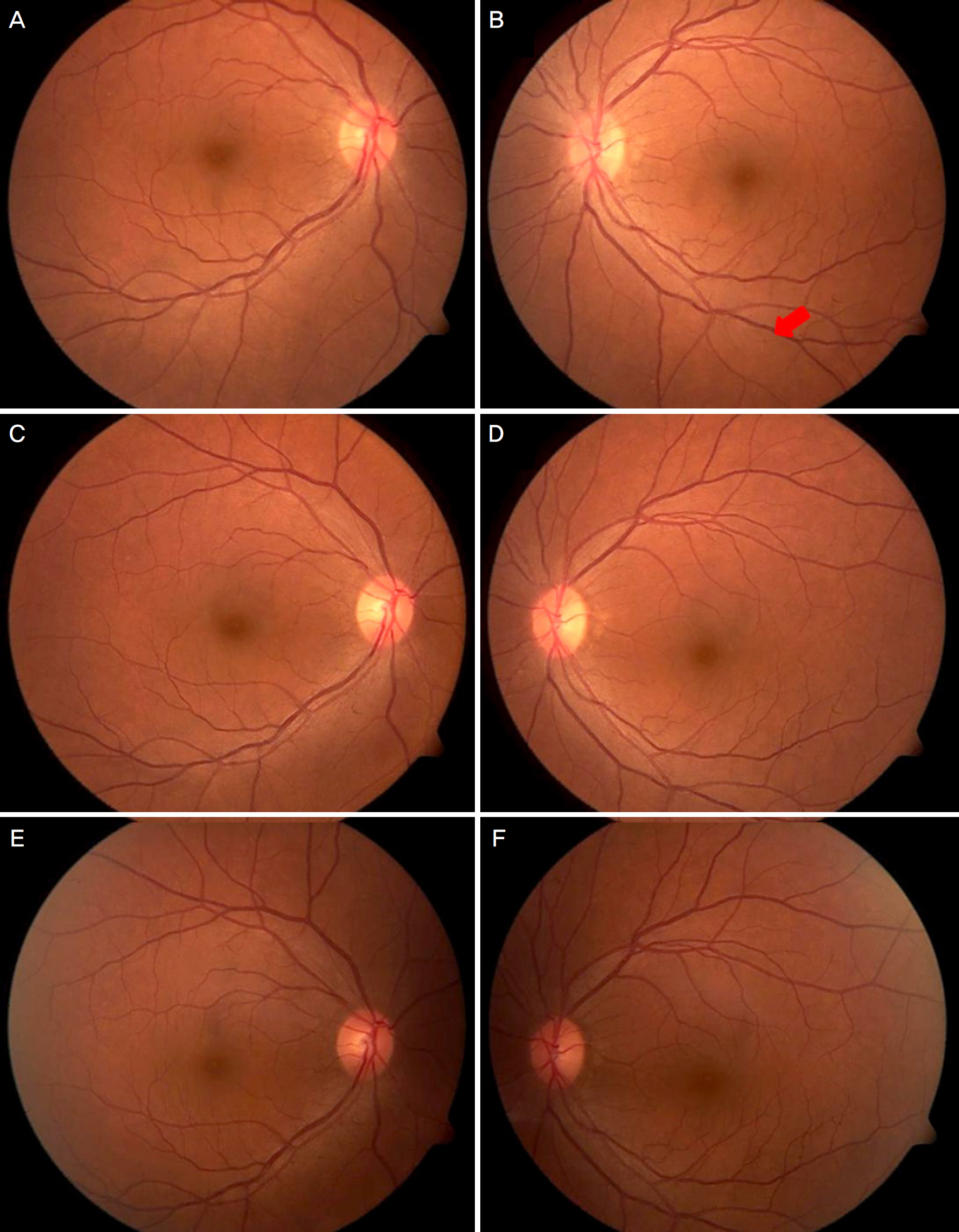J Korean Ophthalmol Soc.
2016 Sep;57(9):1498-1505. 10.3341/jkos.2016.57.9.1498.
A Case of Posterior Reversible Encephalopathy Syndrome with Bilateral Visual Impairment
- Affiliations
-
- 1Department of Ophthalmology, KyungHee University Hospital, Kyung Hee University School of Medicine, Seoul, Korea. khjinmd@khmc.or.kr
- KMID: 2351886
- DOI: http://doi.org/10.3341/jkos.2016.57.9.1498
Abstract
- PURPOSE
To report a case of recovery of bilateral cortical blindness in a patient with posterior reversible encephalopathy syndrome.
CASE SUMMARY
A 46-year-old female visited the ophthalmology department due to abrupt visual acuity decrease. Ten days earlier, she had received conservative management due to anemia caused by menorrhagia and uterine prolapse. She underwent a gynecological operation to remove a uterine myoma two days previously, and was given a blood transfusion postoperatively because of excessive bleeding. After the transfusion, she complained of acute blurred vision. Her best corrected visual acuity (BCVA) was hand motion 10 cm in both eyes. There were no abnormal specific findings except retinal dot hemorrhage at the temporal side in the left eye on fundus examination. Her pupillary light reflex was normal and optical coherence tomography examination was unremarkable in both eyes. However, flash visual evoked potential findings showed reduced P100 amplitude in both eyes and she was diagnosed with posterior reversible encephalopathy syndrome based on brain magnetic resonance imaging. After close observation without any treatment, the symptoms gradually improved. Finally, her BCVA recovered to 1.0 and P1 and P100 amplitudes were restored to normal range in both eyes at 16 weeks from the first diagnosis.
CONCLUSIONS
A patient complained of bilateral visual loss without other neurological symptoms after chronic blood loss and blood transfusion. She recovered visual acuity completely with prompt diagnosis of posterior reversible encephalopathy syndrome and close observation only.
Keyword
MeSH Terms
-
Anemia
Blindness, Cortical
Blood Transfusion
Brain
Diagnosis
Evoked Potentials, Visual
Female
Hand
Hemorrhage
Humans
Leiomyoma
Magnetic Resonance Imaging
Menorrhagia
Middle Aged
Ophthalmology
Posterior Leukoencephalopathy Syndrome*
Reference Values
Reflex
Retinaldehyde
Tomography, Optical Coherence
Uterine Prolapse
Vision Disorders*
Visual Acuity
Retinaldehyde
Figure
Reference
-
References
1. Hinchey J, Chaves C, Appignani B, et al. A reversible posterior leukoencephalopathy syndrome. N Engl J Med. 1996; 334:494–500.
Article2. Pavlakis SG, Frank Y, Kalina P, et al. Occipital-parietal encephalopathy: a new name for an old syndrome. Pediatr Neurol. 1997; 16:145–8.
Article3. Kahana A, Rowley HA, Weinstein JM. Cortical blindess: abdominal and radiologic findings in reversible posterior leukoencephalopathy syndorme: case report and review of the literature. Ophthalmology. 2005; 112:e7–e11.4. Honkaniemi J, Kähärä V, Dastidar P, et al. Reversible posterior leukoencephalopathy after combination chemotherapy. Neuroradiology. 2000; 42:895–9.
Article5. Rubin AM, Kang H. Cerebral blindness and encephalopathy with cyclosporin A toxicity. Neurology. 1987; 37:1072–6.
Article6. Shin RK, Stern JW, Janss AJ, et al. Reversible posterior leukoencephalopathy during the treatment of acute lymphoblastic leukemia. Neurology. 2001; 56:388–91.
Article7. Do DV, Rismondo V, Nguyen QD. Reversible cortical blindness in preeclampsia. Am J Ophthalmol. 2002; 134:916–8.
Article8. Schwartz RB, Feske SK, Polak JF, et al. Preeclampsia-eclampsia: clinical and neuroradiographic correlates and insights into the pathogenesis of hypertensive encephalopathy. Radiology. 2000; 217:371–6.
Article9. Ito Y, Niwa H, Iida T, et al. Post-transfusion reversible posterior leukoencephalopathy syndrome with cerebral vasoconstriction. Neurology. 1997; 49:1174–5.
Article10. Ikeda M, Ito S, Hataya H, et al. Reversible posterior leukoencephalopathy in a patient with minimal-change nephrotic syndrome. Am J Kidney Dis. 2001; 37:E30.
Article11. Fugate JE, Rabinstein AA. Posterior reversible encephalopathy syndrome: clinical and radiological manifestations, pathophysiology, and outstanding questions. Lancet Neurol. 2015; 14:914–25.
Article12. Antunes NL, Small TN, George D, et al. Posterior leukoencephalopathy syndrome may not be reversible. Pediatr Neurol. 1999; 20:241–3.
Article13. Lindsberg PJ, Sirén AL, Hallenbeck JM. Microvascular perfusion during focal vasogenic brain edema: a scanning laser fluorescence microscopy study. Microvasc Res. 1997; 53:92–103.
Article14. Byrom FB. The pathogenesis of hypertensive encephalopathy and its relation to the malignant phase of hypertension; experimental evidence from the hypertensive rat. Lancet. 1954; 267:201–11.
Article15. Park SK, Rha JH, Han SR, et al. Immunosuppressants induced reversible posterior dominant encephalopathy-a capillary leak syndrome. J Korean Neurol Assoc. 1997; 15:1125–35.16. Karuppannasamy D, Vikrant K, Raghuram A, Kumaar TM. Cortical visual loss in posterior reversible encephalopathy abdominal in late postpartum eclampsia: case series. Indian J Ophthalmol. 2014; 62:635–8.17. Niyadurupola N, Burnett CA, Allen LE. Reversible posterior leu-coencephalopathy syndrome: a cause of temporary cortical blindness. Br J Ophthalmol. 2005; 89:924–5.
Article18. Garg RK. Postpartum posterior leukoencephalopathy syndrome. J Assoc Physicians India. 2003; 51:211–3.19. Kauntia R, Valsalan R, Seshadri S, et al. Late postpartum preeclampsia with posterior reversible encephalopathy syndrome. Indian J Med Sci. 2009; 63:508–11.
Article20. Boughammoura A, Touzé E, Oppenheim C, et al. Reversible angiopathy and encephalopathy after blood transfusion. J Neurol. 2003; 250:116–8.
Article21. Huang YC, Tsai PL, Yeh JH, Chen WH. Reversible posterior leukoencephalopathy syndrome caused by blood transfusion: a case report. Acta Neurol Taiwan. 2008; 17:258–62.22. Singh K, Gupta R, Kamal H, et al. Posterior reversible encephalopathy syndrome secondary to blood transfusion. J Clin Neurosci. 2015; 22:592–4.
Article23. Ay H, Buonanno FS, Schaefer PW, et al. Posterior leukoencephalopathy without severe hypertension: utility of diffusion-weighted MRI. Neurology. 1998; 51:1369–76.
Article24. Norman JK, Parke JT, Wilson DA, McNall-Knapp RY. Reversible posterior leukoencephalopathy syndrome in children undergoing induction therapy for acute lymphoblastic leukemia. Pediatr Blood Cancer. 2007; 49:198–203.
Article25. Kim KI, Choe BK, Kim HS, et al. A case of reversible posterior leukoencephalopathy in a child with acute lymphoblastic leukemia. Clin Pediatr Hematol Oncol. 2007; 14:78–82.
- Full Text Links
- Actions
-
Cited
- CITED
-
- Close
- Share
- Similar articles
-
- Posterior Reversible Encephalopathy Syndrome in a Patient with Intoxication of Arisaema amurense
- Posterior Reversible Encephalopathy Syndrome in a Patient with Spinal Metastasis
- A case of Posterior Reversible Encephalopathy Syndrome Presenting as Generalized Seizure after Delivery
- Posterior Reversible Encephalopathy Syndrome
- Malignant Posterior Reversible Encephalopathy Syndrome: A Case of Posterior Irreversible Encephalopathy Syndrome





